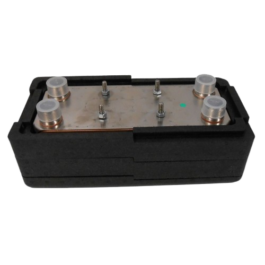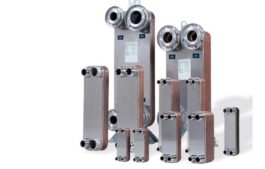Plate-Type
Plate-type heat exchangers are efficient devices used for transferring heat from one fluid to another without the fluids coming into direct contact. These heat exchangers consist of multiple thin plates arranged in a frame, with alternating channels for the hot and cold fluids to flow through. The plates are typically made of stainless steel, titanium, or other materials suitable for heat exchange applications.
The design of plate-type heat exchangers allows for a large surface area in a relatively compact unit. This enables efficient heat transfer between the fluids. As the hot and cold fluids flow through the channels on opposite sides of the plates. This is where heat is transferred from the hot fluid to the cold fluid through the plates.
One of the key advantages of plate-type heat exchangers is their high heat transfer efficiency. Also, the turbulent flow created by the plate arrangement enhances heat transfer rates. This makes these heat exchangers ideal for applications where maximizing thermal performance is essential.
Maintenance
Plate-type heat exchangers are also known for their flexibility and ease of maintenance. Additionally, the modular design of the plates allows for easy inspection, cleaning, and replacement if needed. Furthermore, the compact size and lightweight construction of these heat exchangers make them ideal for installations where space is limited.
These heat exchangers find applications in various industries, including HVAC and refrigeration. In addition, chemical processing, and food and beverage production. Moreover, they are commonly used for cooling or heating applications, such as in liquid-to-liquid or liquid-to-gas heat exchange processes.
Overall, plate-type heat exchangers offer an efficient, compact, and cost-effective solution for thermal management requirements in industrial processes. Additionally, their high heat transfer efficiency, reliability, and ease of maintenance. This makes them a popular choice for a wide range of applications where precise temperature control and energy efficiency are paramount.
Showing all 6 resultsSorted by popularity
-

Plate and Frame Heat Exchangers
Price range: $ 1,981.00 through $ 9,522.00Select options This product has multiple variants. The options may be chosen on the product page -

Heat Exchanger Insulation
Price range: $ 93.00 through $ 740.00Select options This product has multiple variants. The options may be chosen on the product page -

Heat Exchanger Mounting
Read more -

Heat Exchanger Y-Strainers
Read more -

10″x20″ Brazed Plate Heat Exchangers
Price range: $ 1,019.00 through $ 8,466.00Select options This product has multiple variants. The options may be chosen on the product page -

5″x12″ Brazed Plate Heat Exchangers
Price range: $ 285.00 through $ 1,045.00Select options This product has multiple variants. The options may be chosen on the product page
